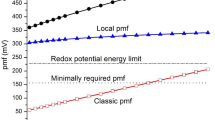Summary
The high membrane potential ofAcetabularia (E m=−170 mV) is due to an electrogenic pump in parallel with the passive diffusion system (E d=−80 mV) which could be studied separately in the cold, when the pump is blocked. Electrical measurements under normal conditions show that the pump pathway consists of its electromotive forceE p with two elementsP 1 andP 2 in series;P 2 is shunted by a large capacitance (C p=3 mF cm−2). The nonlinear current-voltage relationship ofP 1 (light- and temperature-sensitive) could be determined separately; it reflects the properties of a carrier-mediated electrogenic pump. The value ofE p (−190 mV) indicates a stoichiometry of 2∶1 between electrogenically transported charges and ATP. The electrical energy, normally stored inC p, compares well with the metabolic energy, stored in the ATP pool. The nonlinear current-voltage relationship ofP 2 (attributed to phosphorylating reactions) is also sensitive to light and temperature and is responsible for the region of negative conductance of the overall current-voltage relationship. The power of the pump (1 μW cm−2) amounts to some percent of the total energy turnover. The high Cl− fluxes (1 nmol cm−2 sec−1) and the electrical properties of the plasmalemma are not as closely related as assumed previously. For kinetic reasons, a direct and specific Cl− pathway between the vacuole and outside is postulated to exist.
Similar content being viewed by others
References
Adrian, R. H., Chandler, W. K., Hodgkin, A. L. 1970. Voltage clamp experiments in striated muscle fibres.J. Physiol. 208: 607
Barry, P. H., Hope, A. B. 1969a. Electroosmosis in membranes: Effects of unstirred layers and transport numbers. I. Theory.Biophys. J. 9: 700
Barry, P. H., Hope, A. B. 1969b. Electroosmosis in membranes: Effects of unstirred layers and transport numbers. II. Experimental.Biophys. J. 9: 729
Beth, K. 1953. Experimentelle Untersuchungen über die Wirkung des Lichtes auf die Formbildung von kernhaltigen und kernlosenAcetabularia-Zellen.Z. Naturforsch. 8b: 334
Brändle, E. P. O., Kötter, R., Zetsche, K. 1975. Changes of pH in culture solution ofAcetabularia caused by proton flux.Protoplasma 83: 173
Cole, K. S. 1961. Non-linear current-potential relations in an axon membrane.J. Gen. Physiol. 44: 1055
Cram, W. J. 1968. Compartmentation and exchange of chloride in carrot root tissue.Biochim. Biophys. Acta 163: 339
Findlay, G. P., Hope, A. B., Pitman, M. G., Smith, F. A., Walker, N. A. 1971. Ionic relations of marine algae. III.Chaetomorpha: Membrane electrical properties and chloride fluxes.Aust. J. Biol. Sci. 24: 731
Finkelstein, A. 1964. Carrier model for active transport of ions across a mosaic membrane.Biophys. J. 4: 421
Gläsel, R. M., Zetsche, K. 1975.36Chloride fluxes ofAcetabularia.Protoplasma 83: 175
Gradmann, D. 1970. Einfluss von Licht, Temperatur und Aussenmedium auf das elektrische Verhalten vonAcetabularia.Planta 93: 323
Gradmann, D. 1974. Wirkung des Lichts auf die elektrogene Pumpe vonAcetabularia. Zusammenfassungen der Vorträge zur Tagung der Deutschen Botanischen Gesellschaft, Würzburg:70
Gradmann, D., Bentrup, F. W. 1970. Light-induced membrane potential changes and rectification inAcetabularia.Naturwissenschaften 57: 46
Gradmann D., Bokeloh, G. 1975. Energy consumption of the electrogenic pump inAcetabularia mediterranea.Protoplasma 83: 172
Gradmann, D., Klemke, W. 1974. Current-voltage relationship of the electrogenic pump inAcetabularia.In: Membrane Transport in Plants. U. Zimmermann and J. Dainty, editors. p. 131. Springer-Verlag, Berlin-Heidelberg-New York
Gradmann, D., Wagner, G., Gläsel, R. M. 1973. Chloride efflux during light-triggered action potentials inAcetabularia mediterranea.Biochim. Biophys. Acta 323: 151
Hämmerling, J. 1944. Zur Lebensweise, Fortpflanzung und Entwicklung verschiedener Dasycladaceen.Arch. Protistenk. 97: 7
Hogg, J., Williams, E. J., Johnston, R. J. 1968. A simplified method for measuring membrane resistances inNitella translucens.Biochim. Biophys. Acta 150: 518
Hogg, J., Williams, E. J., Johnston, R. J. 1969. The membrane electrical parameters ofNitella translucens.J. Theoret. Biol. 24: 317
Lilley, R. McC., Hope, A. B. 1971. Chloride transport and photosynthesis in cells ofGriffithsia.Biochim. Biophys. Acta 226: 161
MacRobbie, E. A. C. 1969. Ion fluxes to the vacuole ofNitella translucens.J. Exp. Bot. 20: 236
Mergenhagen, D., Schweiger, H. G. 1974. Circadian rhythmicity: Does intercellular synchronization occur inAcetabularia?Plant Sci. Lett. 3: 387
Mitchell, P. 1961. Coupling of phosphorylation to electron and hydrogen transfer by a chemiosmotic type of mechanism.Nature 191: 144
Mummert, H., Gradmann, D. 1976. Correlation of potassium fluxes and electrical properties of the membrane ofAcetabularia. (In preparation)
Saddler, H. D. W. 1970a. The ionic relations ofAcetabularia mediterranea J. Exp. Bot. 21: 345
Saddler, H. D. W. 1970b. The membrane potential ofAcetabularia mediterranea.J. Gen. Physiol. 55: 802
Saddler, H. D. W. 1971. Spontaneous and induced changes in the membrane potential and resistance ofAcetabularia mediterranea.J. Membrane Biol. 5: 250
Schilde, C. 1966. Zur Wirkung des Lichtes auf das Ruhepotential der grünen Pflanzenzelle.Planta 71: 184
Schilde, C. 1968. Schnelle photoelektrische Effekte der AlgeAcetabularia.Z. Naturforsch. 23b: 1369
Slayman, C. L., Long, W. S., Lu, C.Y.-H. 1973. The relationship between ATP and an electrogenic pump in the plasma membrane ofNeurospora crassa.J. Membrane Biol. 14: 305
Slayman, C. W., Rees, D. C., Orchard, P. P., Slayman, C. L. 1975. Generation of adenosine triphosphate in cytochrome-deficient mutants ofNeurospora.J. Biol. Chem. 250: 396
Strehler, B. L. 1970. Adenosin-5-triphosphat und Creatinphosphat Bestimmung mit Luciferase.In: Bergmeyer, Methoden der Enzymatischen Analyse. U. H. Bergmeyer, editor. Vol. 2, p. 2036. Verlag Chemie, Weinheim/Bergstrasse
Walker, N. A., Smith, F. A. 1975. Intracellular pH inChara corallina measured by DMO distribution.Plant Sci. Lett. 4: 125
Author information
Authors and Affiliations
Rights and permissions
About this article
Cite this article
Gradmann, D. Analog circuit of theAcetabularia membrane. J. Membrain Biol. 25, 183–208 (1975). https://doi.org/10.1007/BF01868574
Received:
Revised:
Issue Date:
DOI: https://doi.org/10.1007/BF01868574




